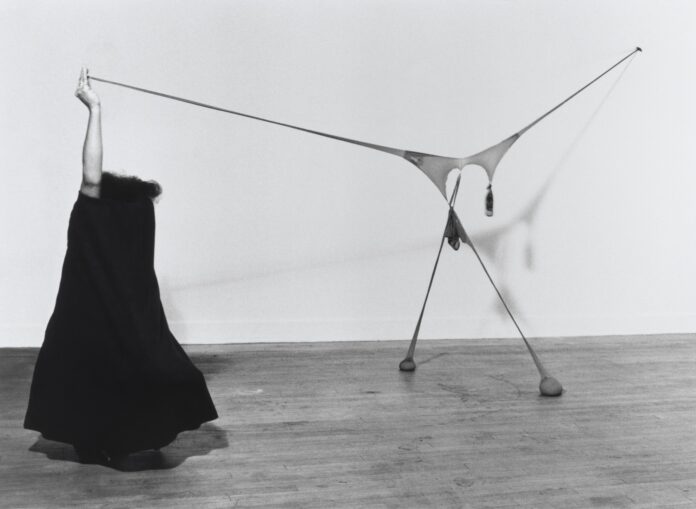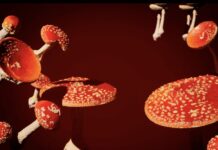
L’arte non ha età
In un periodo in cui da parte di gallerie e musei vengono proposte mostre quasi esclusivamente a giovani artisti o a artisti degli anni ’50 e ’70, è abbastanza sorprendente questa mostra incentrata su 16 artiste di oltre 70 anni. Meglio, artiste di età compresa tra 71 e 105 anni con una carriera che copre oltre 50 anni che provengono da 14 paesi diversi. E ancora determinate a proseguire il proprio percorso creativo con incrollabile convinzione. Another Energy: Power to Continue Challenging – 16 Women Artists from around the World (Un’altra energia: il potere di continuare a sfidare – 16 donne artiste da tutto il mondo) a cura di Kataoka Mami (Direttore, Mori Art Museum), e Martin Germann (Curatore indipendente) al Mori Art Museum di Tokyo, Japan dal 22 Aprile al 26 Settembre 2021. Dipinti, video, sculture, installazioni, performance. Non manca nulla.
Etel Adnan
Ad esempio Etel Adnan nata nel 1925 a Beirut lavora dagli anni ’60, come poetessa, scrittrice e pittrice, collegando con immagini e testo, Oriente e Occidente, rappresentando la diaspora intellettuale araba. «To write is to draw», afferma la poetessa che esprime così la sua relazione dinamica con il mondo, con la memoria e la storia. Abbiamo visto il suo lavoro a Punta della Dogana in occasione della mostra “Luogo e Segni” (2019).
Phyllida Barlow
Phyllida Barlow nata nel 1944 a Newcastle upon Tyne, Regno Unito, ha rappresentato il Regno Unito alla 57a Biennale di Venezia nel 2017. Le sue imponenti installazioni in cartone, tessuto, compensato, polistirolo, tela e cemento, dipinte con colori industriali e vibranti, risultano colossali accatastamenti a volte eccessivi, a volte giocosi.
Anna Boghiguian
Anna Boghiguian nata nel 1946 al Cairo, vista a Documenta 13 a Kassel, si muove tra lavori estremamente drammatici e altri che ricordano il teatro delle marionette e delle ombre. Al Castello di Rivoli una grande retrospettiva nel 2017 raccoglieva uno straordinario numero di taccuini, disegni, pitture, fotografie, sculture scenografiche, installazioni ambientali, libri d’artista da lei realizzati dall’inizio della sua attività negli anni ottanta del secolo scorso fino a oggi. Ha anche vinto il Leone d’Oro per il miglior padiglione (Armenia) alla 56° Biennale di Venezia nel 2015.
Miriam Cahn
Miriam Cahn, nata nel 1949 a Basilea, Svizzera, è stata influenzata dal movimento anti-nucleare, dalle questioni sociali come la discriminazione e la violenza, la guerra e la sua identità di donna ebrea. Nel 2017 ha preso parte a documenta 14. Ha usato solo nero, bianco e sfumature di grigio nei suoi primi lavori e ha iniziato a usare il colore nel 1994, per evidenziare parti scelte delle sue figure umane, i genitali, il seno, le labbra o gli occhi, suggerendo un’idea di fragilità e fecondità.
Lili Dujourie
I primi lavori di Lili Dujourie, nata nel 1941 a Roeselare, Belgio, sono considerati una reazione femminista ai dogmi impersonali del minimalismo degli anni ’60. Dagli anni ’80, ha realizzato piccoli oggetti in argilla che rappresentano forme organiche come ossa e foglie. La serie “Maelstrom” (2009-10) consiste in opere più grandi di ferro curvo che hanno a che fare con la potente corrente di marea vicino alla Norvegia, evocando l’energia delle onde.
Anna Bella Geiger
Anche i lavori della brasiliana Anna Bella Geiger, nata nel 1933 a Rio de Janeiro, riflettono le forme organiche del corpo in uno stile che il critico d’arte Mário Pedrosa ha definito la “fase viscerale”. Successivamente la cartografia e la topografia sono diventate motivi importanti nel suo lavoro, influenzate dal marito, Pedro Geiger, geografo, per via del problema della divisione e la riallocazione delle terre indigene.
Beatriz González
Beatriz González, nata nel 1938 a Bucamaranga, Colombia, ha prodotto opere partendo da immagini sia dalla storia dell’arte occidentale che dai giornali locali, con tende, mobili, carte da parati, quasi una risposta al movimento della pop art. Ultimamente i suoi lavori fanno riferimento agli attuali conflitti socio-politici nel suo Paese d’origine, la Colombia.
Carmen Herrera
Amica degli artisti dell’allora emergente espressionismo astratto e poi pioniera dell’astrazione geometrica, Carmen Herrera, nata nel 1915 all’Avana, con la serie di sculture “Estructuras (Strutture)” ha promosso l’astrazione orientata verso l’architettura.
Kim Soun-Gui
Nata nel 1946 a Buyeo, Corea del Sud, Kim Soun-Gui si è trasferita in Francia nel 1971 lavorando sul multimediale: video, performance, installazione, suono, scultura, fotografia, col supporto della semiologia ed estetica ma influenzata dalle filosofie buddiste e taoiste e dall’indagine di Ludwig Wittgenstein sul linguaggio, esplora la natura del tempo o il gioco linguistico sulle questioni della vita e dell’arte.
Suzanne Lacy
Arte socialmente impegnata quella di Suzanne Lacy, nata nel 1945 a Wasco, CA. Con sede principalmente a Los Angeles dagli anni ’70, attraverso il suo dialogo con le comunità locali ha affrontato questioni sociali come il femminismo, il razzismo, l’invecchiamento, la violenza, l’accesso ai sistemi di comunicazione.
Mishima Kimiyo, Miyamoto Kazuko e Senga Nengudi
E ancora Mishima Kimiyo nata nel 1932 a Osaka, per i suoi lavori bidimensionali altamente sperimentali alla fine degli anni ’50, Miyamoto Kazuko nata nel 1942 a Tokyo, assistente di Sol LeWitt, Senga Nengudi nata nel 1943 a Chicago, Illinois, che subisce l’influenza delle forme teatrali giapponesi come il Kabuki e il Butoh, così come le pratiche rituali dell’Africa occidentale per costruire il suo linguaggio visivo.
Nunung WS
Nunung WS, nata nel 1948 a Lawang, East Jawa, Indonesia, ha studiato belle arti all’Accademia di Belle Arti di Surabaya e in onore del tradizionale divieto islamico dell’idolatria, sin dall’inizio della sua carriera si è concentrata su dipinti in stile astrattista geometrico, trovando ispirazione nei paesaggi montani e nella luce del sole di Giava.
Arpita Singh
Arpita Singh, nata nel 1937 a Baranagar, India. Testi e i numeri appaiono nei suoi dipinti in piani pittorici che intrecciano astratto e figurativo, essendo le sue fonti insegne pubblicitarie, TV e giornali.
Robin White
Robin White, nata nel 1946 a Te Puke, Nuova Zelanda, ha lavorato attivamente a una serie di progetti insieme a donne di Kiribati, Fiji, Tonga e di altre parti del Pacifico.
Insomma, Arte finché morte non ci separi!
Art has no age
In a period in which galleries and museums exhibitions are offered almost exclusively to young artists or artists of the 1950s and 1970s, it is quite surprising this exhibition focused on 16 artists over 70 years old. Even better, artists between the ages of 71 and 105 years with a career spanning over 50 years who come from 14 different countries. And still determined to continue their creative journey with unwavering conviction. Another Energy: Power to Continue Challenging – 16 Women Artists from around the World curated by Kataoka Mami (Director, Mori Art Museum) and Martin Germann (independent curator) at the Mori Art Museum of Tokyo, Japan; from 22 April to 26 September 2021. Paintings, video, sculpture, installations, performances. Missing nothing.
Etel Adnan
For example, Etel Adnan was born in 1925 in Beirut, and has been working since the 1960s: as a poet, writer and painter, linking with pictures and text, both East and West, representing the Arab intellectual diaspora. “To write is to draw”, says the poet who thus expresses her dynamic relationship with the world, with both memory and history. We saw her work at Punta della Dogana on the occasion of the “Location and Signs” exhibition (2019).
Phyllida Barlow
Phyllida Barlow was born in 1944 in Newcastle, Tyne, in the United Kingdom. She represented Great Britain at the 1957 Venice Biennial in 2017. Her impressive cardboard installations, fabric, plywood, polystyrene, canvas and cement, painting with industrial and vibrant colours, resulted in colossal stacking and sometimes excessive, sometimes playful.
Anna Boghiguian
Anna Boghiguian was born in Cairo in 1946. Her art was seen at Documenta 13 in Kassel. She moves between extremely dramatic and others reminiscent of puppet and shadow theatre. At the Castello di Rivoli, a major retrospective in 2017, collected an extraordinary number of notebooks, drawings, paintings, photography, scenographic sculptures, environmental instillations, artist’s books she made since the beginning of her activity in the 1980’s to this day. She also won the Leone d’Oro for the best pavillian (Armenia) at the 56th Biennale di Venezia in 2015.
Miriam Cahn
Miriam Cahn, born in Basilea, Switzerland in 1949, was influenced by the anti-nuclear movement, from social issues such as discrimination and violence, war and her identity as a Jewish woman. In 2017, she took part in Documenta 14. She used only black, white and shades of grey in her early works. She started to use colour in 1994, to highlight selected parts of her human figures, genitals, breasts, lips or eyes, suggesting an idea of fragility and fruitfulness
Lili Dujourie
The first works of Lili Dujourie (born in 1941 at Roeselare, Belgium) are considered a feminist reaction to the impersonal dogma’s of 1960s minimalism. Since the 1980s, she made small clay objects that represent organic shapes such as bones and leaves. The “Maelstrom” series (2009-2010) consisted of larger works of curved iron that had to do with the powerful tidal current near Norway, evoking the energy of the waves.
Anna Bella Geiger
Also the works of the Brazilian Anna Bella Geiger (born in 1933 at Rio de Janeiro) reflect the organic shapes of the body in a style which the art critic, Mário Pedrosa, called it the “visceral phase”. Subsequently the cartography and the topography had become important reasons in her work, influenced by her husband, Pedro Geiger (geographer), because of the problem of the division and reallocation of indigenous lands.
Beatriz González
Beatriz González was born in 1938 at Bucamaranga, Colombia. She produced works starting from images from both Western art history and local newspapers, with curtains, furniture, wallpaper, almost a response to the pop art movement. Lately, her works refer to the current socio-political conflicts in her country of origin, Colombia.
Carmen Herrera
Friend of the artists of the then emerging abstract expressionism and then pioneer of geometric abstraction, Carmen Herrera (born in 1915 in Havana), with her series of sculptures “Estructuras” (Structures) promoted architecture-oriented abstraction.
Kim Soun-Gui
Born in 1946 at Buyeo, South Korea, Kim Soun-Gui transferred to France in 1971 working in multimedia: video, performance, installations, sound, sculpture, photography, with the support of semiology and aesthetics. She was influenced by Buddhist and Taoist philosophies and from Ludwig Wittgenstein’s investigation of language. She explored the nature of time or on the linguistic game on the issues of life and art.
Suzanne Lacy
Socially engaged art that of Suzanne Lacy, born in 1946 at Wasci, CA. She was primarily based in Los Angeles since the 1970s, through her dialogue with local communities she has addressed social issues such as feminism, racism, aging, violence, access to communication systems.
Mishima Kimiyo, Miyamoto Kazuko e Senga Nengudi
Mishima Kimiyo, born in 1932 at Osaka, she had highly experimental two-dimensional works at the end of the 1950s. Miyamoto Kazuko, born in Tokyo in 1942, was an assistant to Sol LeWitt. Senga Nengudi was born in 1943 in Chicago, Illinois, which was influenced by Japanese theatrical forms, such as Kabuki and Butoh, as well as the ritual practices of West Africa to construct its visual language.
Nunung WS
Nunung WS, born in 1948 at Lawang, East Jawa, Indonesia, studied fine arts at the Academy if Fine Arts of Surabaya, and in honor of the traditional Islamic ban on idolatry, since the beginning of her career she has concentrated on paintings in the geometric abstraction style, finding inspiration in the mountain landscapes and in the light of the Java sun.
Arpita Singh
Arpita Singh was born in 1937 in Baranagar, India. Texts and numbers appear in her paintings in pictorial planes that intertwine abstract and figurative, her sources being commercials, TV and newspapers.
Robin White
Robin White, born in 1946 in Te Puke, New Zealand, has actively worked on a number of projects together with women of Kiribati, Fiji, Tonga and other parts of the Pacific.
In short, Art until death do us part!







